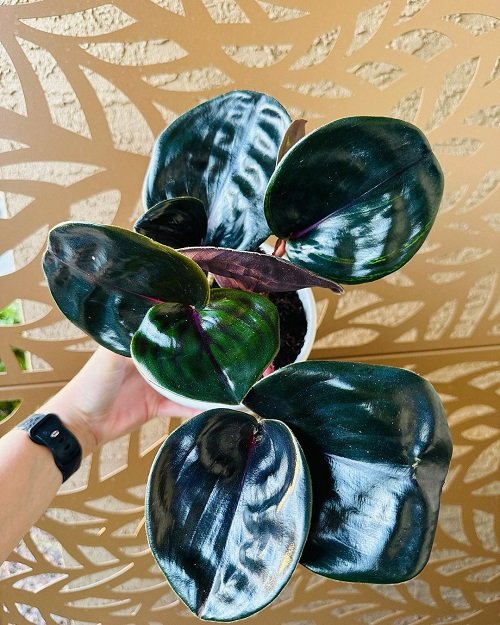If you like plants with dark foliage, then Geogenanthus ciliatus should be your pick! Here are all the details about growing it!

If you want an easy to grow specimen that stands out with its almost black leaves, then look no further than Geogenanthus ciliatus. The best part – it also flowers!
Learn How to Grow Astrantia here
Geogenanthus ciliatus Information
The Geogenanthus ciliatus, also known as the geo plant, is a flowering species belonging to the Commelinaceae family. Originally from the rainforests of Peru, Ecuador, and Columbia, it is recognized for its glossy dark purple or green foliage.
With fleshy stems and vibrant purple blooms, the Geogenanthus ciliatus adds a touch of exotic beauty as an indoor decorative plant. Due to their rarity, finding these plants may be a challenge, as they belong to the exclusive Geogenanthus genus, known to have only three species.
The geo plant is a safe choice for households with children and pets, as it is non-toxic. Enjoy the allure of this unique plant without worries about potential harm.
Read about Alocasia odora Care and Growing Guide
Propagating Geogenanthus Ciliatus

To propagate a Geogenanthus ciliatus, stem cuttings are the most effective method, preferably during the spring when the plant is in its active growth phase. Select a healthy stem (4-6 inches long) with one or two leaves, making a clean cut just below a leaf node.
Let the cutting dry for a day or two, and then plant it in a well-draining potting mix. Water well and ensure it gets bright and indirect light. Keep it safe from direct sun exposure during this time. The cutting will form roots in 4-6 weeks.
Propagate Any Plant Cutting Quickly Using this Trick
Best Pot Size for Growing Geogenanthus ciliatus
You can start Geogenanthus ciliatus in a 5-6 inches pot, which will be good for a few years, depending on its growth and spread, keep on repotting it into a size bigger container than the old one.
Here are Plant Pot Sizes from Inches to Gallon
Requirements for Growing Geogenanthus ciliatus

Location
The optimal light for Geogenanthus ciliatus is filtered sunlight, providing bright yet indirect illumination. While they can tolerate low-light areas for a period, geo plants require some bright light over time to promote healthy leaf growth.
Direct sunlight should be avoided as it can scorch the delicate leaves. If relocation is not possible, using a light cloth or curtain to filter the sunlight or using growth lights in low-light areas can be beneficial.
Soil
For optimal growth of Geogenanthus ciliatus, use a well-draining soil mix that retains moisture. Maintain a slightly acidic to neutral pH level, around 6.5 to 7.
Here is How to Check Your Soil pH at Home
Add perlite, peat moss, coco coir, or orchid bark to the potting mix for ideal conditions. Ensure the pot has proper drainage holes to allow for easy water flow.
Water
Geogenanthus ciliatus hates overwatering. In general, water the plant when the top inch (2.5 cm) of soil feels slightly dry to the touch. This may require watering approximately once or twice a week during warmer months.
Here are the best ways to water plants
Temperature and Humidity
The ideal temperature range for Geogenanthus ciliatus is around 65-75°F (18-24°C). This temperature range provides optimal conditions for growth and overall health.
Geogenanthus ciliatus thrives in environments with moderate to high humidity levels, typically ranging from 50% to 70%. Here are some ways to increase humidity indoors:
- Place a humidifier near the plant or use a room humidifier to add moisture to the air.
- Grouping plants together can create a microclimate of increased humidity.
- Set the plant on a tray or saucer filled with water and pebbles. As the water evaporates, it increases the humidity around the plant. Ensure that the plant’s roots do not sit directly in the water to avoid waterlogging.
- Mist the plant’s foliage with water using a spray bottle. Mist the leaves regularly, especially during drier periods.
Here are 10 Ways To Increase Humidity For Houseplants That Work
Geogenanthus ciliatus Care

Fertilizer
Use a balanced, water-soluble fertilizer like 20-20-20 or similar. Dilute it to half or quarter strength to avoid overfertilizing, as this can lead to salt buildup in the soil and cause damage to the plant.
Fertilize Geogenanthus ciliatus every 5-6 weeks during the growing season, which typically spans from spring to early fall. Reduce or suspend fertilization during the winter months when the plant’s growth slows down.
Try these Best DIY Potassium Fertilizer Recipes
Pests and Diseases
Geogenanthus Ciliatus is prone to infestations by common indoor houseplant pests like mealybugs, thrips, and spider mites. It is important to regularly check the plant for any signs of pests or diseases. If an infestation is detected, isolate the affected plant and treat it with suitable pesticides like neem oil or insecticidal soap.
Due to its preference for high humidity and consistent moisture, Geogenanthus ciliatus can be susceptible to fungal diseases. If you notice any signs of disease, promptly isolate the affected plant and treat it with a suitable fungicide.
Here is How to Dispose of Diseased Plants and Weeds
To prevent other diseases, avoid overwatering and ensure proper air circulation around Geogenanthus ciliatus.

